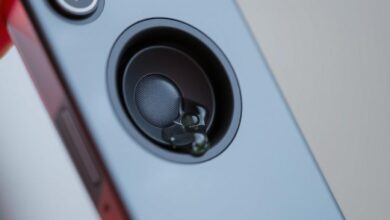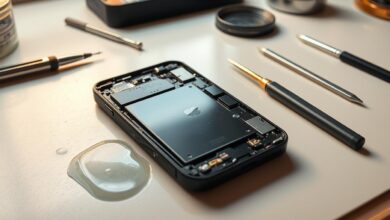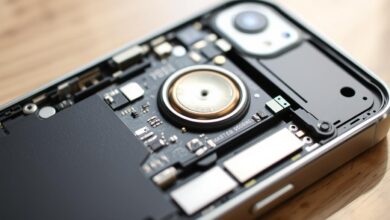how to get liquid out of phone
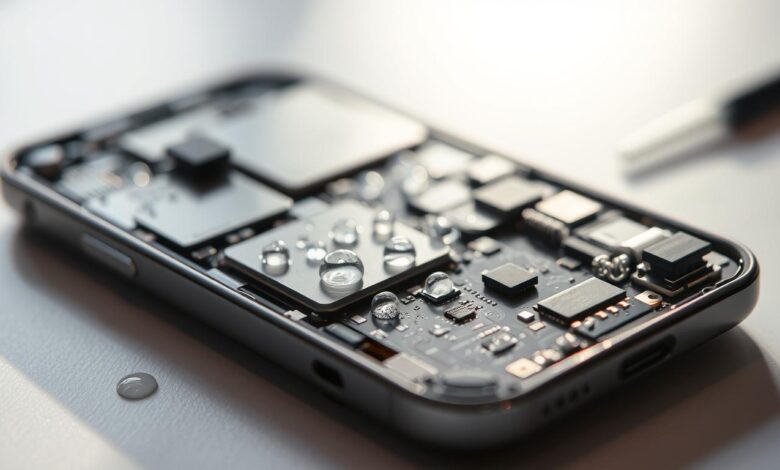
When your phone meets liquid, it can be very stressful. It’s important to act fast to lessen damage and maybe save your phone.
I’ve put together a step-by-step guide to help you fix your phone after liquid damage. The main thing is to act quickly and follow the right steps to dry your phone. This will help get it working again.
Knowing how urgent and what steps to take can really help save your phone. In this guide, I’ll show you how to handle the situation. You’ll get all the info you need to deal with it well.
Key Takeaways
- Act quickly to minimize damage when your phone is exposed to liquid.
- Turn off your phone immediately to prevent short circuits.
- Remove accessories and dry the exterior with a soft cloth.
- Avoid using heat to dry your phone, as it can cause further damage.
- Use desiccants or uncooked rice to absorb moisture from your phone.
- Be patient and monitor your phone’s condition as it dries.
Understanding Phone Liquid Damage
Phone liquid damage is a common issue. It can happen when phones accidentally fall into water or when liquids spill on them. Knowing how to handle this damage is important.
Types of Liquid Damage and Their Severity
The severity of liquid damage can vary. It depends on the type of liquid and how long the phone was exposed.
Freshwater vs. Saltwater vs. Other Liquids
Different liquids can harm a phone in different ways. Saltwater is especially bad because it can corrode. Knowing this helps us understand the damage better.
Partial vs. Complete Submersion
How much of the phone was underwater matters too. Being fully submerged usually means more damage.
How Liquid Affects Internal Components
Liquids can really mess up a phone’s inside parts. They can cause short circuits and corrosion.
Short-Circuit Risks
When liquid hits the phone’s circuits, it can short circuit right away. This can make the phone stop working or fail completely.
Corrosion Timeline
Corrosion happens slowly and keeps causing damage. It’s crucial to act fast to prevent more harm.
Act Fast: Immediate Steps After Phone Gets Wet
When your phone gets wet, you must act quickly. This can help save your device from damage.
Power Off Your Device Immediately
Turn off your phone as soon as it gets wet. This is the first and most important step. It stops the electrical current and prevents corrosion.
Do not try to turn it on or charge it until it’s completely dry. This simple step can save you from a costly repair.
Remove Accessories, SIM Card, and Battery (if possible)
Quickly remove any accessories to help your phone dry faster. Take out the SIM card and any other removable storage cards to prevent damage.
iPhone Removal Specifics
For iPhone users, removing the SIM card is easy. Use a paper clip or the SIM ejector tool provided. Gently push the tool into the small hole on the SIM card tray and eject it.
Android Removal Specifics
Android devices have a similar process to remove the SIM card. Check your device’s manual if you’re unsure about how to eject the SIM card tray on your specific model.
Wipe External Moisture Carefully
Gently wipe the outside of your phone with a soft cloth to remove any visible moisture. Be careful not to push any liquid further into the phone’s openings.
Safe Wiping Materials
Use a soft, lint-free cloth, such as a microfiber cloth, to wipe your phone. Avoid using paper towels or other abrasive materials that could scratch the screen or damage the device.
Areas Requiring Special Attention
Pay special attention to areas around ports, buttons, and speakers. Use a cotton swab or a small, dry brush to gently remove moisture from these areas.
According to a repair expert, “The key to successful water damage repair is speed and careful handling. The sooner you act and the more gently you handle your device, the better its chances of recovery.”
| Immediate Action | Purpose |
|---|---|
| Power off the device | Prevent short circuits and further damage |
| Remove accessories and SIM card | Reduce damage to components and aid drying |
| Wipe external moisture | Remove visible liquid and prevent further ingress |
Common Myths About Wet Phone Recovery
Many methods for saving a wet phone are based on myths, not facts. People try different ways to fix a water-damaged phone, but some are not safe. We will clear up these myths and share safer ways to fix your phone.
Why Rice Isn’t the Best Solution
Using rice to dry a wet phone is a common idea, but it’s not the best phone water damage solution. It’s thought that rice absorbs moisture from the phone. But, it has its problems.
The Science Behind the Rice Myth
Rice can absorb moisture, but it’s not good for a phone’s electronics. The drying process is slow, which can lead to corrosion. This can harm your phone for a long time.
Potential Damage from Rice Particles
Rice can also cause problems by getting stuck in your phone’s small spaces. This can make it hard to fix or use your phone again. For tips on saving a wet phone, check out wikiHow.
Dangerous Methods to Avoid
There are other methods that can harm your phone. It’s important to know these to avoid damage.
Heat Sources and Their Risks
Using heat like hair dryers or ovens to dry a phone is dangerous. Heat can damage your phone’s parts or cause a short circuit. This method can make your phone unusable.
Harmful Household Solutions
Some people use items like silica gel packets to dry their phones. But, using chemicals or cleaning solutions can harm your phone. It’s best to use safe methods to dry your phone.
How to Get Liquid Out of Phone: Effective Methods
If your phone got wet, don’t worry. There are ways to dry it out. The important thing is to act fast and use the right methods to avoid damage.
Using Silica Gel Packets
Silica gel packets are great for drying a wet phone. They soak up moisture from the air and around your phone.
Creating a Silica Gel Drying Chamber
To make silica gel packets work better, create a drying chamber. Put your phone in a sealed container with silica gel packets. Close it and let it sit for a few hours or overnight.
How Long to Leave Your Phone
How long to leave your phone in the chamber varies. Generally, keep it for 24 to 48 hours. This gives the silica gel enough time to soak up moisture.
Commercial Desiccants and Drying Agents
There are other products like commercial desiccants and drying agents. They are made to absorb moisture and can dry out your phone well.
Recommended Products
Look for desiccant packets made for electronics and moisture-absorbing materials like Dri-Die. Choose products designed for electronics.
Application Methods
To use these products, put them in a container with your phone. Follow the instructions for how much to use and for how long. Usually, you’ll need 24 to 48 hours.
“The sooner you start drying your phone, the higher the chances of successful recovery.”
Air Drying Techniques
Air drying is also effective for drying a wet phone. This method involves placing your phone to get good airflow and drainage.
Optimal Positioning for Drainage
To help with drainage, place your phone with the ports facing down. This lets gravity help remove liquid from your phone.
Creating Airflow Without Heat
It’s crucial to create airflow without heat. Heat can harm your phone’s parts. You can do this by placing your phone near a fan or in a well-ventilated area.
By using these methods, you can dry out your phone and get it working again. Remember, acting fast and being patient are key.
Dealing with Different Types of Liquids
The type of liquid your phone gets wet with matters a lot. It affects how bad the damage is and what you should do to fix it. Knowing the differences helps you handle the problem better.
Freshwater vs. Saltwater Damage
Freshwater and saltwater damage are different. Saltwater is more harmful because it has lots of salt. This makes the damage happen faster.
Saltwater’s Accelerated Corrosion
Saltwater can quickly harm your phone’s inside parts. The salt can cause fast oxidation. This can damage your phone for good if not fixed right away.
Freshwater Treatment Steps
For freshwater damage, start by drying the outside gently. Then, use desiccants or silica gel to dry the inside. Don’t use heat, as it can harm your phone’s inside parts.
Soda, Coffee, and Other Sugary Liquids
Liquids like soda and coffee can leave sticky stuff behind. This makes drying harder. They can get into your phone’s small spaces and cause problems.
Addressing Sticky Residue
To clean sticky stuff, use a mild cleaning solution. But be careful not to push the liquid deeper into your phone.
Additional Cleaning Requirements
Some liquids need more cleaning. You might have to take your phone apart and clean it carefully. This depends on the liquid’s type and how thick it is.
Alcoholic Beverages and Cleaning Solutions
Drinks with alcohol and some cleaning solutions can also harm your phone. They can corrode parts or react with your phone’s materials.
Chemical Reaction Concerns
The chemicals in these liquids can harm your phone’s parts. It’s important to act fast and carefully to avoid damage.
Neutralizing Cleaning Agents
If your phone got wet from a cleaning solution, you need to get rid of any leftover chemicals. Gently wipe the area with a soft cloth and distilled water. Then, dry it well.
| Liquid Type | Damage Potential | Recommended Action |
|---|---|---|
| Freshwater | Moderate | Dry with desiccants or silica gel |
| Saltwater | High | Immediate drying, avoid corrosion |
| Sugary Liquids | High | Clean sticky residue carefully |
| Alcoholic Beverages | Moderate to High | Neutralize and dry |
Using Isopropyl Alcohol for Cleaning
To remove water from your phone, knowing how to use isopropyl alcohol is key. This alcohol, also known as rubbing alcohol, is great for cleaning electronics. It dries quickly and doesn’t leave any residue.
When and How to Use Isopropyl Alcohol
Isopropyl alcohol can help clean corrosion and dry out moisture inside your phone. But, use it carefully to avoid harming sensitive parts.
Concentration Guidelines
The alcohol’s concentration matters a lot. A concentration of 90% or higher is recommended for cleaning electronics safely. Lower concentrations might have more water, which could harm your phone.
Application Techniques
When using isopropyl alcohol, be gentle and don’t spray it on components. Instead, dampen a cotton swab or soft cloth with the alcohol. Then, carefully clean the affected areas.
Safety Precautions When Cleaning Electronics
Isopropyl alcohol is effective, but safety is key. Protect yourself and your phone’s parts.
Ventilation Requirements
Make sure you’re in a well-ventilated area when using isopropyl alcohol. It releases strong fumes that can be harmful.
Component Protection
Don’t let isopropyl alcohol touch sensitive components like screens, adhesives, or certain plastics. It can damage these parts.
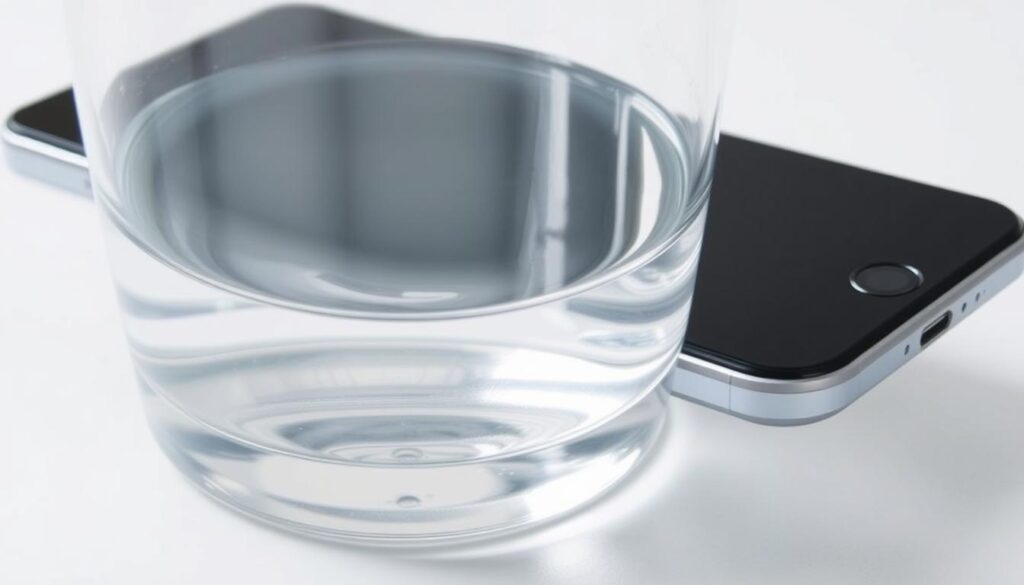
By knowing when and how to use isopropyl alcohol, you can remove liquid from your phone. This might save it from water damage.
Advanced DIY Liquid Removal Techniques
Advanced DIY liquid removal techniques can fix water-damaged phones better. It’s key to act fast and right to lessen damage.
Using Compressed Air Safely
Compressed air is useful for removing liquid from your phone. But, use it carefully to avoid more harm.
Pressure Settings and Distance
Use low to moderate pressure to avoid pushing debris deeper. Keep a safe distance to prevent damage from the air stream.
Directional Techniques
Direct the air into openings and crevices, like the SIM card slot and charging port. Use short bursts to avoid pushing liquid deeper.
Disassembly Techniques for Common Phone Models
For serious liquid damage, you might need to take apart your phone. This needs care and the right tools.
iPhone Disassembly Basics
iPhone models differ in disassembly needs. You’ll often need to remove the screen and other parts to get to the inside. Use a pentalobe screwdriver first and follow a guide for your model.
Android Disassembly Basics
Android phones also need specific disassembly steps. You’ll usually remove the back cover and other parts to get to the inside. Check a repair manual for your device to use the right methods.
Using Vacuum Methods
Vacuum methods can remove liquid from your phone safely.
Low-Suction Techniques
Use a low-suction vacuum or a special electronics vacuum tool. Gently remove liquid from ports and crevices. Avoid too much suction to prevent damage.
Vacuum Adapter Options
Some vacuums have adapters for specific phone areas. These adapters are great for tight spaces.
The Critical Drying Timeline
When your phone gets wet, time is crucial. The first 24 hours are especially important to reduce damage. Knowing how to dry your phone quickly can help save it. We’ll cover the key steps right after your phone gets wet and how to dry it properly.
First 24 Hours: Critical Actions
The first 24 hours are key. Quick and right actions can stop more damage and help fix your water damage phone repair.
Hour-by-Hour Guide
Here’s what to do hour by hour in the first 24 hours:
- 0-1 hour: Turn off your phone, take off accessories, and wipe off water.
- 1-6 hours: Use desiccants or silica gel to soak up moisture. Don’t turn on your phone.
- 6-24 hours: Keep drying with desiccants. Watch for signs your phone is drying, like no more moisture issues.
Signs of Successful Drying
Look for these signs your phone is drying well:
- No corrosion or mineral buildup.
- No moisture in the SIM card slot or openings.
- Your phone turns on without failing right away.
Even if your phone looks dry, it might still have internal damage.
48-72 Hours: Secondary Measures
After 24 hours, keep going with extra steps to dry your phone completely.
Extended Drying Techniques
If your phone was in water for a long time or in bad water, you might need extra drying. Use commercial desiccants or dry your phone in a cool, dry place for a while.
When to Attempt Power-Up
Wait at least 48 hours before trying to turn on your phone. But, this can change based on how wet it was. If unsure, it’s safer to wait 72 hours.

When to Seek Professional Help
DIY fixes can work for small water damage issues. But, if you’re not sure about the damage or if your phone still doesn’t work, it’s time to get help from a pro.
Signs of Severe Water Damage
Knowing how bad the water damage is is key. You need to check for both visual and functional signs.
Visual Indicators
Look out for these visual signs of serious water damage:
- Corrosion on the circuit board or other internal parts
- Water damage indicators that have changed color (usually pink or red)
- Visible mineral deposits or staining on the phone’s internal parts
Functional Warning Signs
Also, watch for these functional signs of severe water damage:
- The phone not turning on or showing no signs of life
- Faulty charging ports or irregular charging behavior
- Distorted audio, unresponsive buttons, or other malfunctioning features
Finding Reputable Repair Services
Once you decide your phone needs a pro, find a good repair service. Look at the tech’s qualifications and ask important questions.
Evaluating Technician Qualifications
Make sure your phone is in good hands. Look for technicians who are:
- Certified by the phone’s manufacturer or a recognized electronics repair association
- Experienced in repairing your specific phone model
Questions to Ask Before Service
Before you give your phone to the repair service, ask them:
- What is the diagnosis process, and what will it cost?
- What is the warranty on their repairs?
- Can they provide references or reviews from previous customers?
Cost of Professional Water Damage Repair
Water damage on your phone can be costly. The damage’s extent, the repair type, and the service provider all affect the price. Knowing this helps you budget better.
Price Ranges for Different Repair Options
Repair costs for water damage vary. It depends on whether you need part fixes or a full restore.
Component-Specific Repairs
Fixing specific parts like the logic board, battery, or screen is cheaper. Prices range from $50 to $200, based on the part and complexity.
Full Restoration Services
For major damage, full restoration is needed. This means replacing the logic board, housing, and more. Costs can be $200 to $400 or more, close to buying a new phone.
Insurance and Warranty Considerations
Insurance and warranties are key when dealing with water damage. They can lower your repair costs.
Manufacturer Warranty Policies
Most warranties don’t cover water damage. But, some premium services or extended warranties might. Always check your warranty to see what’s covered.
Phone Insurance Coverage
Insurance policies for phones vary. Some cover water damage, others don’t. If you have insurance, check your policy. Some offer coverage for accidental damage, which can save you money.
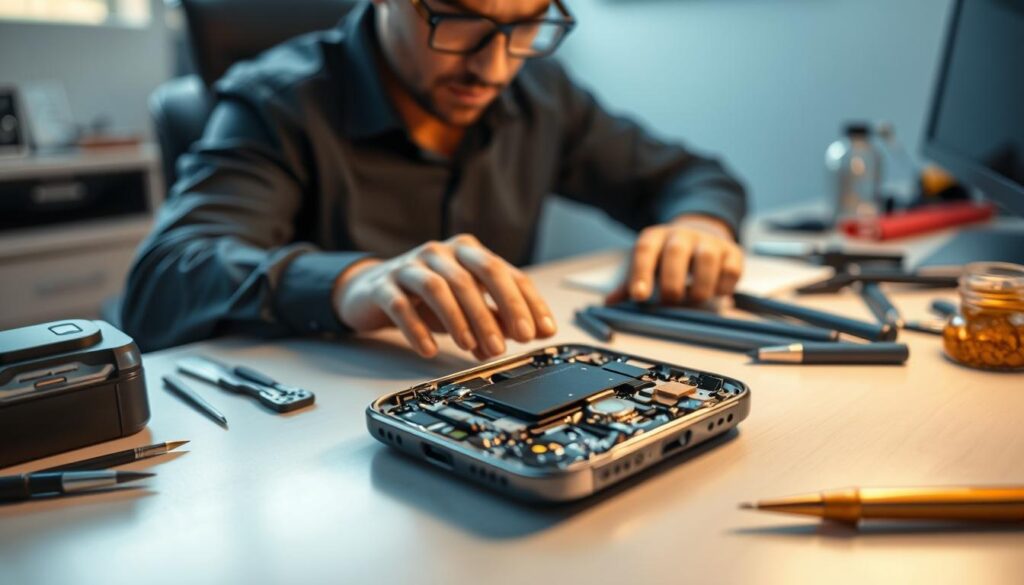
How to Test if Your Phone is Fully Dry
After drying your waterlogged phone, it’s time to check if it’s dry. It’s important to make sure your phone is dry before trying to turn it on. This is because a wet phone can get damaged even more when you try to power it on. I’ll show you how to safely turn on your phone and test if it’s dry.
Safe Power-Up Procedures
When you turn on your phone after it got wet, be careful. You need to do it slowly to avoid more damage.
Initial Testing Without Battery
Try to remove the battery and test the phone’s inside without it. This helps find any short circuits that could be bad when the battery is back in. If your phone’s battery can’t be removed, be extra careful and watch for any problems.
Gradual Power Restoration
When you’re ready to turn on your phone, do it slowly. First, plug it into a charger and see how it acts. If it charges right, that’s a good sign. Then, turn it on and watch how it works.
Testing Phone Functions Systematically
After turning it on, test your phone’s functions one by one. This makes sure everything is working right.
Basic Function Checklist
First, check simple things like making calls, texting, and connecting to Wi-Fi. Make sure the screen works well and the phone doesn’t get too hot.
Advanced Feature Testing
Then, test more complex things like the camera, Bluetooth, and GPS. If you’re not sure about anything, take it to a pro. You can also look at ifixit for help.
Here’s a simple table to help you remember the testing steps:
| Function | Status | Notes |
|---|---|---|
| Power On | OK | No issues |
| Screen Responsiveness | OK | Touchscreen working |
| Wi-Fi Connectivity | OK | Connected successfully |
| Camera | OK | Both front and rear cameras working |
Preventing Future Liquid Damage
Knowing how to dry your phone is just as important as preventing liquid damage. After dealing with liquid damage, it’s crucial to take steps to avoid it again. Using protective accessories is a great way to do this.
Waterproof Cases and Accessories
Getting a waterproof case can greatly lower the risk of liquid damage. These cases are made to keep your phone dry, even when it’s underwater.
IP Rating Explained
The IP rating shows how well a device or case can handle water and dust. For example, an IP68 rating means it can handle being underwater over 1 meter.
Top Protective Products
Brands like LifeProof and OtterBox offer top waterproof cases. These cases not only protect from water but also from shocks.
Habits to Reduce Risk of Water Exposure
Changing your daily habits can also help prevent liquid damage. It’s important to be mindful of your phone’s surroundings.
Bathroom and Kitchen Safety
Don’t take your phone into the bathroom or kitchen where it might get wet. If you need to have it nearby, use a waterproof pouch or container.
Outdoor Activity Precautions
When swimming or hiking, keep your phone in a safe, dry spot. A waterproof case or bag can offer extra protection.
Water-Resistant Phone Models
Some phones are made to be more water-resistant. Knowing your phone’s water resistance can help you make better choices.
Understanding Manufacturer Water Ratings
Phone makers often give water resistance ratings. For example, some Samsung and Apple phones have specific ratings for water resistance.
Limitations of Water Resistance
Even water-resistant phones can still get damaged by water under certain conditions. For more tips on saving a wet iPhone, check out this resource.
Conclusion
Acting fast and using the right methods are key to fixing a wet phone. Knowing the type and severity of the damage helps decide what to do next. Turning off the phone, removing accessories, and drying the outside can help a lot.
There are good ways to dry your phone, like using silica gel packets or air drying. It’s important to avoid bad methods that can harm your phone more. By following these steps and being patient, you can try to fix your phone.
To keep your phone safe from water, use waterproof cases and be careful where you are. Avoiding water can help keep your phone working well. Learning how to dry your phone is not just for fixing it. It’s also about staying safe and ready for surprises.
FAQ
How do I know if my phone has water damage?
Look for signs like moisture, corrosion, or mineral deposits inside your phone. Also, check if the screen, speaker, or charging port work. Look at the Liquid Damage Indicator (LDI) on your phone, usually in the SIM card tray or battery compartment.
Can I use a hair dryer to dry my wet phone?
No, a hair dryer can push moisture deeper into your phone. Instead, use desiccants, silica gel packets, or air drying to dry it.
How long does it take to dry a wet phone?
Drying time varies based on the damage and method used. It can take hours to days for a phone to dry. Wait at least 24-48 hours before trying to turn it on.
Can I fix water damage on my phone myself?
Yes, you can try fixing water damage by drying, cleaning corrosion, and replacing parts. But, if the damage is severe, get help from a professional repair service.
What is the best way to remove liquid from my phone’s charging port?
Use a soft-bristled brush or cotton swab to remove debris from the charging port. You can also use compressed air or a desiccant. Avoid sharp objects or liquids that can damage the port.
Will my phone’s warranty cover water damage?
Usually, warranties don’t cover water damage. But, some insurance or extended warranties might. Check your policy to see what’s covered.
How can I prevent future liquid damage to my phone?
Use a waterproof case and avoid water exposure. Be careful when using your phone near liquids. Consider a phone with a high IP rating for water resistance.
Can I use isopropyl alcohol to clean my phone’s internal components?
Yes, isopropyl alcohol can clean internal components. But, use the right concentration (90% or higher) and apply it carefully to avoid damage.
What are the signs of severe water damage that require professional help?
Look for extensive corrosion, damaged circuit boards, or non-functional critical components like the motherboard or display. If unsure, seek help from a reputable repair service.
